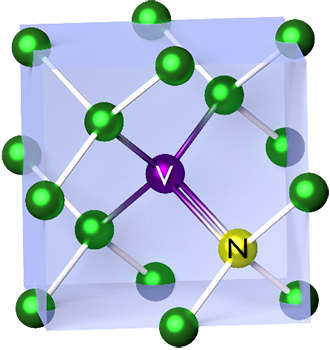Nitrogen-Vacancy (NV) Centers: Quantum Sensors in Diamond
What are Nitrogen-Vacancy (NV) Centers?
Nitrogen-vacancy (NV) centers are atomic-scale defects in the lattice structure of diamond. They consist of a substitutional nitrogen atom adjacent to a vacant lattice site. NV centers have emerged as promising quantum sensors due to their unique electronic and optical properties, enabling high-precision measurements of magnetic fields, electric fields, temperature, and pressure at the nanoscale.

Electronic Structure and Optical Properties
The electronic structure of NV centers is characterized by a ground state triplet with a zero-field splitting of 2.87 GHz between the ms = 0 and ms = ±1 spin sublevels. The NV center can be optically excited from the ground state to an excited state triplet, which then decays back to the ground state via a spin-dependent intersystem crossing. This spin-dependent fluorescence allows for the optical initialization and readout of the NV center's spin state.
NV centers exhibit several desirable optical properties:
- Bright Fluorescence: NV centers emit bright, photostable fluorescence in the visible range (637 nm), making them easily detectable using standard optical techniques.
- Long Coherence Times: The spin states of NV centers have exceptionally long coherence times (up to several milliseconds) at room temperature, enabling high-sensitivity quantum sensing and information processing.
- Optically Addressable Spin States: The spin states of NV centers can be initialized, manipulated, and read out using optical methods, facilitating their use as quantum bits (qubits) for quantum computing and communication.
Sensing Mechanisms
NV centers can sense various physical quantities through the interaction of their spin states with the surrounding environment:
Magnetic Field Sensing
NV centers are highly sensitive to magnetic fields due to the Zeeman effect. The presence of a magnetic field causes a splitting of the ms = ±1 spin sublevels, which can be detected through optically detected magnetic resonance (ODMR) techniques. By measuring the ODMR spectrum, the magnitude and direction of the magnetic field can be determined with high spatial resolution and sensitivity.
Electric Field Sensing
NV centers can also sense electric fields through the Stark effect. The application of an electric field modifies the energy levels of the NV center, resulting in a shift of the ODMR spectrum. By measuring this shift, the electric field strength can be quantified with high precision.
Temperature and Pressure Sensing
The zero-field splitting of the NV center's ground state is sensitive to changes in temperature and pressure. By monitoring the frequency of the zero-field splitting, temperature and pressure variations can be detected with high sensitivity and spatial resolution.
Applications of NV Centers
The unique properties of NV centers have enabled a wide range of applications in quantum sensing, imaging, and information processing:
Nanoscale Magnetic Imaging
NV centers have been used for high-resolution magnetic imaging of biological systems, such as proteins, cells, and tissues. By scanning an NV center in close proximity to a sample, magnetic fields generated by the sample can be mapped with nanoscale resolution. This technique has been applied to study magnetic nanoparticles, spin labeling in biomolecules, and neuronal activity.
Quantum Information Processing
NV centers are promising candidates for quantum information processing due to their long coherence times and optically addressable spin states. They have been used to demonstrate basic quantum operations, such as quantum gates and entanglement, paving the way for the development of diamond-based quantum computers and quantum communication networks.
Nanoscale Thermometry and Pressure Sensing
The temperature and pressure sensitivity of NV centers has been exploited for nanoscale thermometry and pressure sensing applications. NV centers have been used to map temperature gradients in living cells, study thermal transport in nanomaterials, and monitor pressure changes in high-pressure environments.
Challenges and Future Perspectives
Despite the remarkable progress in NV center research, several challenges need to be addressed for their widespread application. One of the main challenges is the scalable fabrication of high-quality NV centers with precise positioning and orientation. Advancements in diamond growth and nanofabrication techniques are crucial for the development of large-scale NV center arrays for quantum sensing and information processing.
Future research directions in NV center technology include the integration of NV centers with photonic and plasmonic nanostructures to enhance their optical properties and sensing capabilities. The development of hybrid quantum systems, combining NV centers with other quantum systems such as superconducting qubits or trapped ions, is also an exciting avenue for exploration. Additionally, the extension of NV center-based sensing to new physical quantities, such as chemical and biological analytes, will further expand their range of applications.
Further Reading
Annual Review of Physical Chemistry, Nitrogen-Vacancy Centers in Diamond: Nanoscale Sensors for Physics and Biology
Progress in Nuclear Magnetic Resonance Spectroscopy, Nanoscale quantum sensing with Nitrogen-Vacancy centers in nanodiamonds – A magnetic resonance perspective
